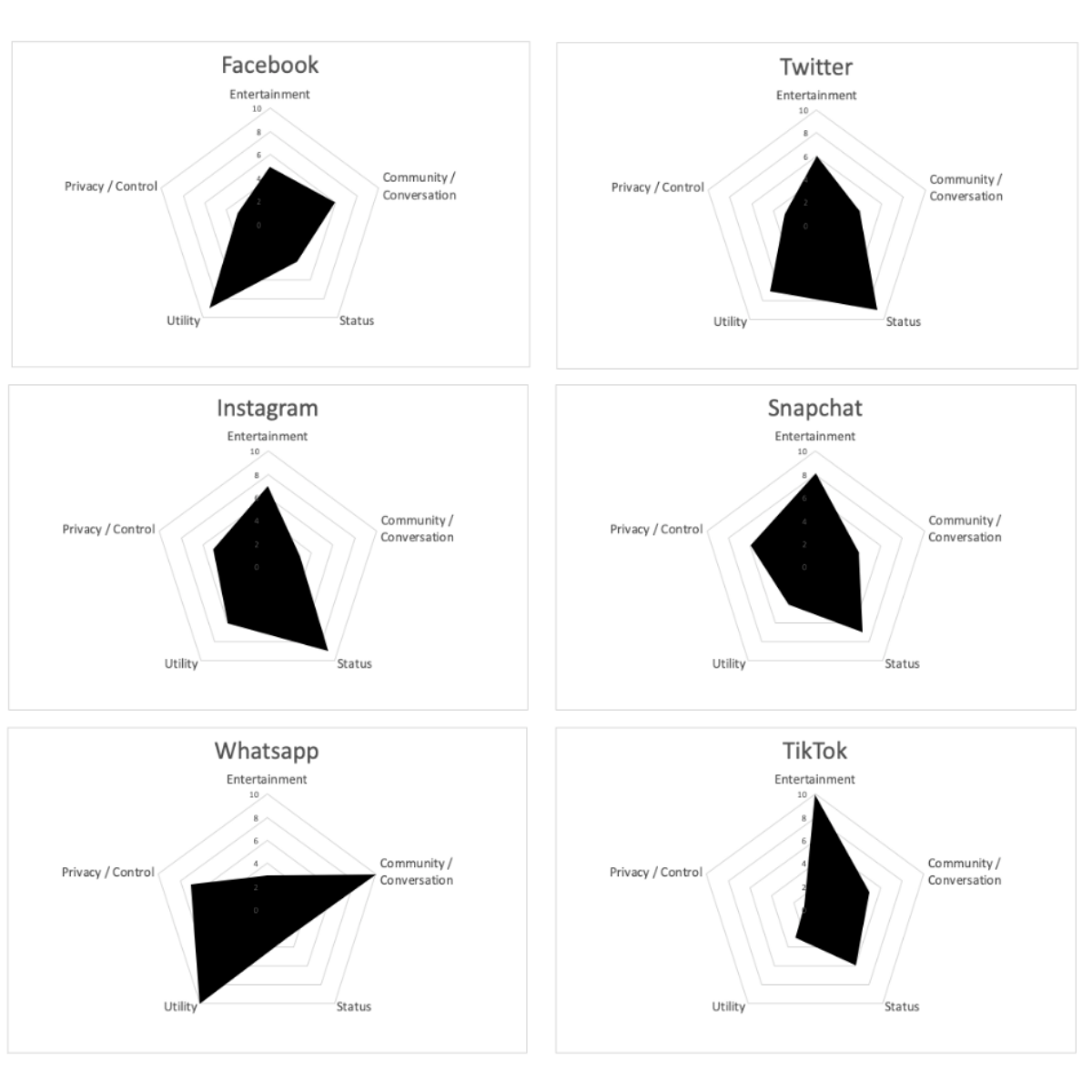There comes a point when social networks hit their peak. In fact, most of the social media giants of today started 10-15 years ago – nearly an entire generation back. Today, as their growth begins to slow, they must acquire new companies to stay relevant, and for many, their original value proposition morphs – now in favor of revenue, margin, or user growth.
What is perhaps most notable about many of these social media companies is that they are in fact, no longer social. Most social media companies initially rose to prominence through a small, controlled community: Facebook with Harvard students, WhatsApp through private group messages, Snapchat’s domination of 1:1 photo messages with your friends. This feeling of being pulled in by a friend or confidante allowed these platforms to grow virally: one friend inviting 10 of their pals; those 10 inviting another 10 and so on. However, now that we’ve hit maturity on these platforms, nearly all have taken a turn from intimate social network to social media with broadcasting as the core use case. In early 2019, Mark Zuckerberg proclaimed that Facebook had hit this peak – functioning as a “town square” – when now the goal is to get back to a “living room.” With this shift towards broadcasting and a massive growth in network size, most of these companies are, I argue, no longer social media platforms. They are status media platforms.
The Building Blocks of Social
All of these “status media” platforms started out originally as social platforms. So what actually makes something social ?
I believe there are 5 key characteristics:
Community and Conversation: A platform must enable connection. It could be one-to-one or it could be one-to-many, but the ability to build some type of community and have a form of discourse is critical. Facebook and Twitter are clear examples of apps that capitalized on this pillar early. Others like Whisper or Meerkat had an early surge of success because of this community element, but failed to deliver on the remaining pillars.
Utility: There must be some useful aspect to the tool to keep users engaged. This might be messaging to stay in touch with friends, a source of news, or a method to save photos of interior decorating ideas you’ve found on the internet. Without true utility, social companies will be novel for a moment but will quickly fall to the wayside as soon as that novelty is exhausted (RIP Yo).
Entertainment: It might be obvious, since social is almost synonymous with “fun,” but social apps need to have some element of entertainment. This type of entertainment is often separate from the utility of an app (though they can be the same – ask any bride who has gotten sucked into an endless pinning frenzy of wedding inspiration on Pinterest). It’s important for any social app to have some core element of entertainment, while also continually evolving what makes it novel and fun.
Privacy and Control: This is perhaps more of an honorary mention. While privacy is not a characteristic that is required to be inherently social, I argue that it is becoming table stakes in today’s era for an app to become successful. This is in part due to the proliferation of social data and the backlash from Cambridge Analytica and Facebook. It’s also a generational shift as Gen Z increasingly cares about privacy and has grown up in an age of Snapchat where shared moments are meant to be just that – ephemeral moments in time.
Status: As humans, we all seek status at our core (remember Klout?). And to reach the success and scale that entrepreneurs’ dreams and VCs’ careers are built upon, a social platform must deliver a mechanism for status to be amassed. This is a pillar that a social app does not necessarily need to have from the beginning. However, I argue that any successful social app will inevitably end up with a status element over time.
When it comes to Social Fundamentals – How do the current platforms stack up today?
Now the quality or strength across each of these pillars can vary wildly for each social platform. At the end of the day, each platform has its own unique footprint based on its performance within these pillars. These footprints will inevitably shift and morph over time as the feature set changes, user behavior shifts, and the networks themselves evolve. Below are rough illustrations of a few social platforms as I see them as of 2019.
Let’s look at Twitter as an example. When Twitter first launched in 2006, it was high on the entertainment and community/conversation pillars. The service was intended to be a fun way to update your friends on your status or what you were doing, no matter how frivolous. Even the name of the company reinforced this idea of frivolity – the dictionary defines the word “Twitter” as “a short burst of inconsequential information.” Twitter was both a form of entertainment (sending fun updates via SMS to the web) and a form of community (bringing groups of friends together to stay more connected on the others’ moods and activities.) The concepts of status, privacy or utility were not even on the radar. In fact, Twitter co-founder, Ev Williams, famously quipped about the app, “Who ever said things have to be useful?”
Well, fast forward to 2019, and Twitter’s footprint across these five pillars has shifted significantly. It turns out that Twitter and its users found a way to make the service extremely useful. For many, Twitter is a first destination for news. It has been used effectively to sway public opinion and win elections. Businesses use it to communicate with customers (and customers use it to complain publicly and get refunds.) Twitter’s elements of status and conversation have also changed. Over time, a certain form of tweet has emerged as one that is worthy of attention or virality. You know it when you see it – pithy, funny, perhaps a bit cutting and sarcastic. It might read a bit like a fortune cookie. It likely has a meme attached as well. It is these types of tweets that get retweeted and amass new followers for a user. And those retweets and follower counts are what provide status on the platform. Given how public your tweets and follower count are, many feel pressure to chase these status metrics. But in doing so, conversation is squashed. If users must communicate in fortune cookie format to gain status, they are no longer authentically sharing and messaging with their group of friends as they once did. And on top of that, the tweets that get the most air time are those fortune cookie quips from individuals who have already amassed significant followers. It becomes a vicious cycle where status is king and conversation is an unfortunate casualty.
***
This is all to demonstrate that the pillars underlying social platforms are universal. They exist in all social apps at some level, yet the strength of each will inevitably shift over time. And as they shift, it opens up opportunities and entry points for new social platforms to emerge (more on this later.)
*
This is one of a series of excerpts from my chapter in Finding Genius: Venture Capital and the Future it Is Betting On. You can check out the entire excerpt series here. The book is available for purchase on Amazon.

